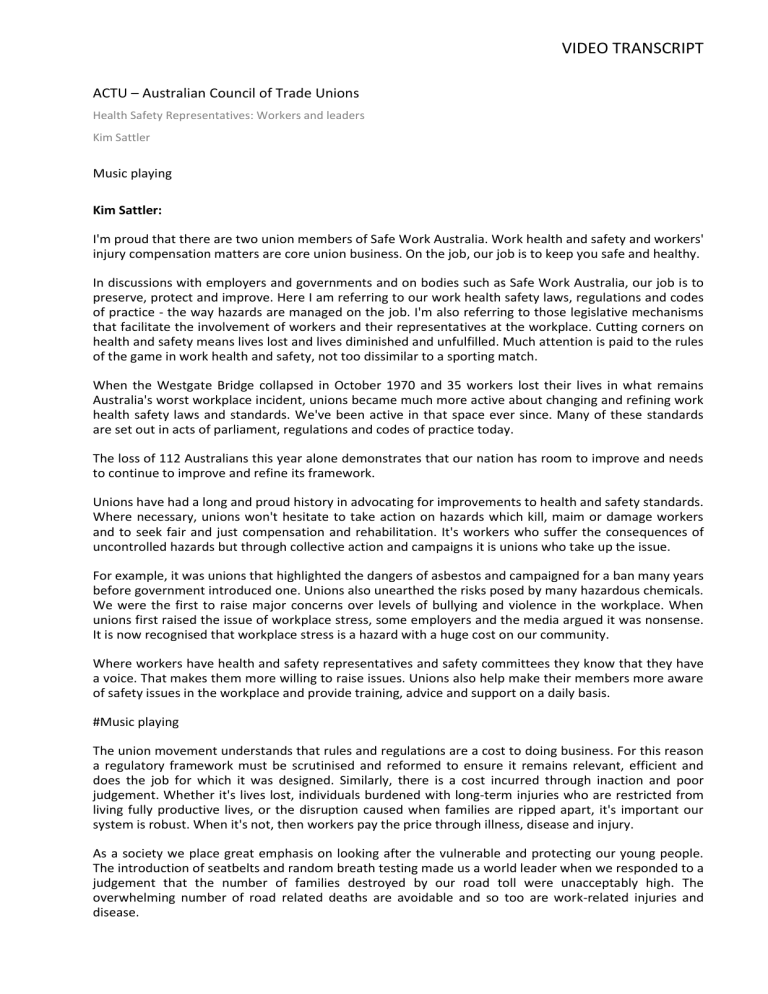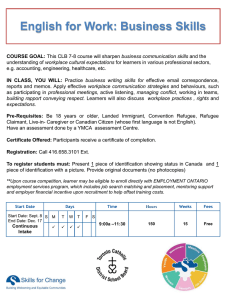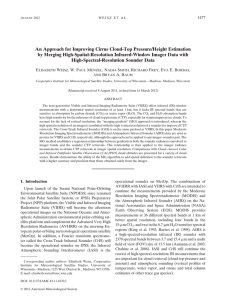ACTU * Australian Council of Trade Unions

VIDEO TRANSCRIPT
ACTU – Australian Council of Trade Unions
Health Safety Representatives: Workers and leaders
Kim Sattler
Music playing
Kim Sattler:
I'm proud that there are two union members of Safe Work Australia. Work health and safety and workers' injury compensation matters are core union business. On the job, our job is to keep you safe and healthy.
In discussions with employers and governments and on bodies such as Safe Work Australia, our job is to preserve, protect and improve. Here I am referring to our work health safety laws, regulations and codes of practice - the way hazards are managed on the job. I'm also referring to those legislative mechanisms that facilitate the involvement of workers and their representatives at the workplace. Cutting corners on health and safety means lives lost and lives diminished and unfulfilled. Much attention is paid to the rules of the game in work health and safety, not too dissimilar to a sporting match.
When the Westgate Bridge collapsed in October 1970 and 35 workers lost their lives in what remains
Australia's worst workplace incident, unions became much more active about changing and refining work health safety laws and standards. We've been active in that space ever since. Many of these standards are set out in acts of parliament, regulations and codes of practice today.
The loss of 112 Australians this year alone demonstrates that our nation has room to improve and needs to continue to improve and refine its framework.
Unions have had a long and proud history in advocating for improvements to health and safety standards.
Where necessary, unions won't hesitate to take action on hazards which kill, maim or damage workers and to seek fair and just compensation and rehabilitation. It's workers who suffer the consequences of uncontrolled hazards but through collective action and campaigns it is unions who take up the issue.
For example, it was unions that highlighted the dangers of asbestos and campaigned for a ban many years before government introduced one. Unions also unearthed the risks posed by many hazardous chemicals.
We were the first to raise major concerns over levels of bullying and violence in the workplace. When unions first raised the issue of workplace stress, some employers and the media argued it was nonsense.
It is now recognised that workplace stress is a hazard with a huge cost on our community.
Where workers have health and safety representatives and safety committees they know that they have a voice. That makes them more willing to raise issues. Unions also help make their members more aware of safety issues in the workplace and provide training, advice and support on a daily basis.
#Music playing
The union movement understands that rules and regulations are a cost to doing business. For this reason a regulatory framework must be scrutinised and reformed to ensure it remains relevant, efficient and does the job for which it was designed. Similarly, there is a cost incurred through inaction and poor judgement. Whether it's lives lost, individuals burdened with long-term injuries who are restricted from living fully productive lives, or the disruption caused when families are ripped apart, it's important our system is robust. When it's not, then workers pay the price through illness, disease and injury.
As a society we place great emphasis on looking after the vulnerable and protecting our young people.
The introduction of seatbelts and random breath testing made us a world leader when we responded to a judgement that the number of families destroyed by our road toll were unacceptably high. The overwhelming number of road related deaths are avoidable and so too are work-related injuries and disease.
Page 2 of 4
Second rate laws put people at risk. Our children, our siblings, our relatives and our friends all deserve to come home safely from their day of work.
#Music playing
Governments need to ensure workers have the best health and safety protections irrespective of where they work and what they do. Every endeavour and every workplace has its hazards but time and again, certain industries stand out as being particularly hazardous and high risk. The transport and agriculture sectors lead the nation in workplace fatalities. There are more accidents in the transport sector than any other.
So far this year 46 workers in the transport industry have died on the job. Farm related fatalities are also unacceptably high – 29 workers have died in the agriculture industry to date this year. We need to do better in coming up with industry specific strategies and target more resources towards combatting fatalities and injuries in these high risk industries.
Workers confront hazards in small and medium businesses not just large ones. The four deaths associated with the Home Insulation Program clearly demonstrate the vulnerability of workers employed by small businesses. Small businesses can be harder for a regulator to reach. There are too many for inspectors to visit each one individually.
The government should consider more targeted education and audit campaigns which explain to small businesses exactly what their responsibilities are. More effort needs to be made in reaching these businesses and ensuring that they are compliant with regulations.
#Music playing
Health and safety representatives or HSRs have been an important part of our system of workplace health and safety regulation since 1985. With the harmonisation of these laws in 2012 it is great to see that the important role of HSRs has been entrenched in the new laws. Given the power in balance between workers and employers, the right to have a say about health and safety is a fundamental protection for workers and it's great to have this protection now enshrined in laws across Australia. There is strong evidence to suggest that worker representation and involvement in work health and safety matters are critical to improving workplaces.
This evidence stretches all the way back to before World War I appearing in factory reports that urged employers to be consultative in their approach to workplace health and safety. Although the overall responsibility for providing a healthy and safe workplace rests with the employer, the HSR has a major role to play in representing members of their workplace by bringing issues of concern to the attention of the employer. In other words, workplace health and safety is not just a management prerogative.
Workers' representatives are the cornerstone of an effective workplace health and safety system.
HSRs are the heroes that take a step forward. The people that care about health and safety in the workplace, that are concerned about their workmates. They are the people who want to contribute and make a difference. HSRs are natural leaders whose skills and abilities have been recognised by their co-workers who elect them to represent them in the workplace. The ACTU and our affiliates regularly conduct surveys of HSRs to find out about their experiences on the frontline. In their responses HSRs talked about what prompted them to become a work health and safety rep. Typical responses included a concern for their work colleagues and a desire to improve the working environment for everybody. HSRs are leaders who are trying to make a difference by being actively involved in their own and others' safety and although HSRs don't receive any payment for their extra work, they do see many non-monetary benefits to their role. This includes the satisfaction gained from being able to give their colleagues a voice and by seeing real, positive changes in the workplace.
Being an HSR is often a tough job – getting the balance right, being tough but fair, staying true to the people you represent, the members of the designated workgroup, at the same time taking into account wider operational interests. HSRs can be faced with serious hazards at the workplace. To be effective,
HSRs need to drive toward a result. In doing so they need to bring all their skills to bear, to be
Page 3 of 4 consultative with both members of the designated workgroup and management, to be knowledgeable, accountable, organised, thorough and proactive.
#Music playing
HSRs are incredibly knowledgeable and well trained but there is a built-in conflict inherent in being both an employee and a workplace representative at the same time. This can cause HSRs some difficulties in the workplace. HSRs need to get the job done whilst maintaining those relationships that are essential to being effective in the long term. HSRs often have busy home lives as well as busy work lives. Many HSRs
I've encountered spend their own time and resources researching and investigating, surfing the net, calling and visiting their unions in search of specialist advice. What is often ignored is the stress and anxiety that is commonly associated with the role.
Regularly subject to criticism, often deluged with unhelpful advice, HSRs can find themselves in confrontational situations not of their own making. We often overlook that HSRs are not paid for the essential role they perform. They are motivated by consideration for others and are passionate about their vital work. The system can't work as intended unless HSRs are supported in their role and unless they have the freedom and protection to perform their legislative functions. Whether it's raising issues, seeking information, issuing provisional improvement notices, seeking the assistance of a union or directing a cease work. When a culture of fear or intimidation exists, those who have a good understanding of the hazards faced at the workplace are denied an effective voice. The intention of our world-class legislation is then defeated.
Overall, we can be proud of the fact that our health and safety laws are among the best in the world but we can always do better. It's always a good idea to reflect on our existing strategy and policy documents to consider areas where we might be able to improve. For example, the ACTU is proud to support the
Australian Work Health and Safety Strategy. This strategy which the ACTU helped to develop sets out the
Australian vision of healthy, safe and productive working lives.
Under the Australian strategy, health and safety capabilities action area, an outcome to be achieved by
2022 is that everyone should have the capabilities, the knowledge, skills and resources to fulfil their role in relation to work health and safety. It urges that those who provide work health and safety advice and of course this includes the vital advocacy role played by our HSRs are provided with the training they need.
Given the expanded role for HSRs in model work health safety laws, I urge that there is a stronger national focus to support our HSRs. Amazingly, we still don't have good national data on just how many
HSRs there are across Australia and it is not good enough that collecting data about the challenges faced by HSRs and the training they might need to address these, is left to union surveys.
I urge this to be a future focus of data and research activity in Safe Work Australia. Of course, any changes to policy and process should only be done following proper consultation. Many of our rules and regulations have been developed over time in a sophisticated and consultative manner with thoughtful input from key stakeholders. This includes business, government and unions on behalf of workers.
Proposed changes need to be considered in the same careful manner.
Since 1979 when Australia ratified the ILO Convention Number 155, Australia's work health and safety system has been based strongly on the principle of tripartism with workers, employers and government working in partnership to develop better rules and processes for health and safety. This long history of tripartism and consultation is one which we can all be proud of.
Many governments bring with them new ways of doing things. However, given its importance all governments need to give proper consideration to any proposed changes in consultation with key social partners. Any erosion of our tripartite system would be a huge step backwards for Australia.
Unfortunately, we have already seen some warning signs that this commitment to consultation is not always being upheld. Recently following a COAG review into our work health safety system both unions and employer associations have raised objections about the lack of transparency and the short
Page 4 of 4 timeframes given for the review. We can and must do better in future reviews of the work health safety system.
In conclusion, Australia is on the right track with its workplace health and safety laws. After decades of hard work by unions and workers in consultation with government and employers, we have managed to build a system we can all be proud of.
With HSRs leading the way on the frontline and unions providing support and leadership, we are now in a fortunate position of having workplace health and safety standards that are among the best in the world.
The ACTU's vision is to improve upon those standards so that all Australian workers get through their work day without incident and all workers arrive home safely at night.
Music playing
[End of Transcript]








